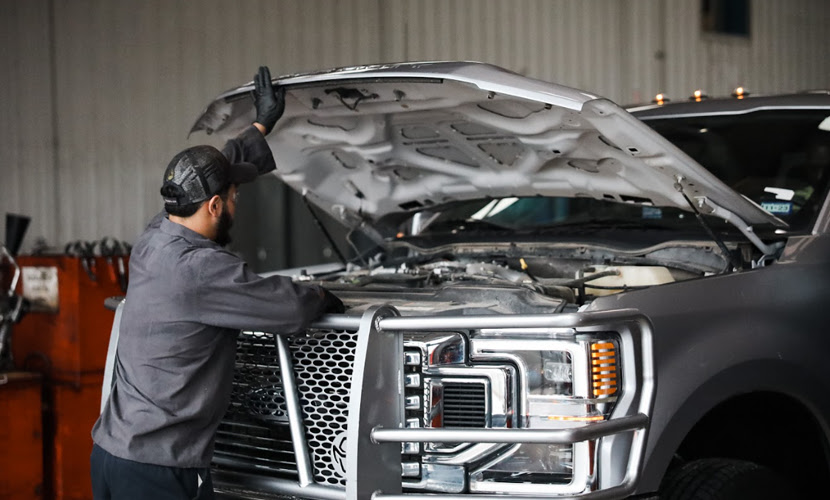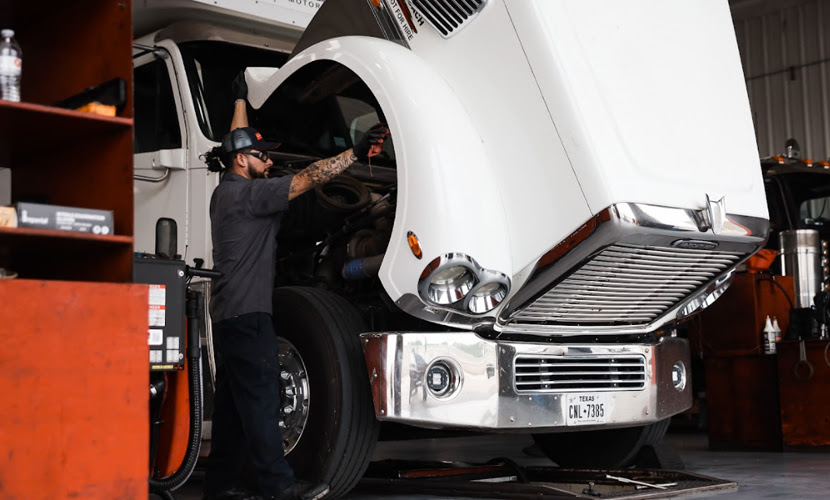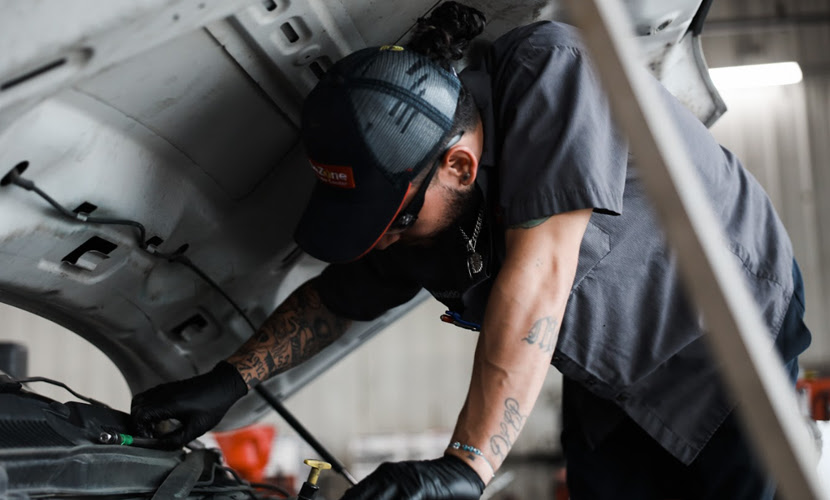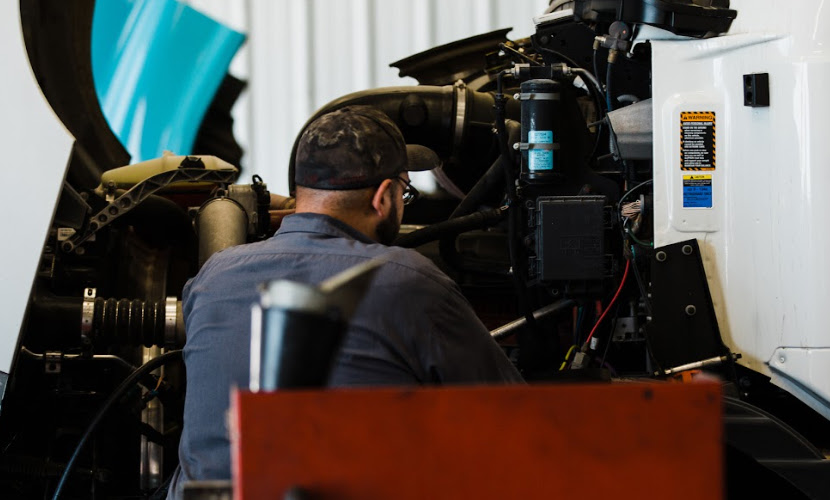Fleet Repairs: Guide to Replacing a Transmission Control Module

Among the many different things that can go wrong with a fleet vehicle on the road, computer problems are some of the most annoying. They’re tiny parts, often smaller than a pack of cards, but they’re critical to the smooth operation of a vehicle. When one starts to fail, all sorts of things can go wrong, from sporadic issues to warning lights pointing at problems that aren’t there to putting a vehicle in “limp mode” or completely preventing operation. Needless to say, these are all problems that need to be solved ASAP for the smooth operation of your fleet.
One of the most important computer modules in a modern vehicle is the TCM, or Transmission Control Module. While these rarely fail, when they do, they’re a huge hassle and can be a costly repair. What do you need to know, what can you do, and what information is useful to have? Let’s run through it all.
Table of Contents
What is a Transmission Control Module?
A transmission control module, or TCM, is also commonly known as a transmission control unit or gearbox control unit. It’s a type of ECU, or Electronic Control Unit, used in modern computerized vehicle engines.
The TCM is a simple computer module with a bit of customized automotive software on it. It’s a lot like the brains of a modern automatic vehicle. It takes in signals, including vehicle speed, wheel speed, throttle position, transmission fluid temperature, traction control, cruise control, and other sensors and switches throughout the vehicle. Using that information, it can engage, disengage, or control various vehicular operations. These include shifting gears, managing torque, and controlling the other modules throughout the vehicle.

To call the TCM critical is almost an understatement. On vehicles that use a TCM, its operation is essential to the smooth operation of the vehicle as a whole. If the TCM has an issue, not only does it cause a variety of problems, but it can also “point the finger” at other modules and sensors or engine parts those sensors monitor because it will throw a warning light about whatever it isn’t getting right. In the worst-case scenarios, this can lead you down a wild goose chase of throwing parts at a vehicle until you realize where the problem actually resides.
Where is the Transmission Control Module Located?
Unfortunately, it could be anywhere.
That’s not very helpful, though, and it’s only kind of true. The TCM is generally going to be located in a few possible places. It might be in the engine bay, located up near the other electronic modules in a nexus of the wiring harness. In some vehicles, it’s located next to or even inside a larger PCM (Powertrain Control Module) that could be located near the battery. Other vehicles place it inside the dashboard behind various instrument clusters.
It’s impossible to say specifically where the TCM is in general because every different make and model of vehicle, from passenger cars to 18-wheelers, will have its own positioning for the component. The only consistency is that it will be in a place away from the worst of the heat of the engine (since heat will kill an electronic part), often sheltered and away from moisture, and somewhere the wiring will reach.

The only way to be sure of where the TCM is in your vehicle will be to consult with the manual for that specific vehicle. Moreover, the owner’s manual won’t tell you, as those are more about operation than service; you’ll need a service manual such as a Haynes Manual or service manual for the vehicle.
A trained technician who is familiar with the make and model of the vehicles you operate will know where the TCM is, as well as how to repair, replace, and reprogram one as necessary. As we’ll discuss later, it’s not generally the best idea to try to DIY this kind of repair, so consulting with a service technician is generally the best idea.
Does Every Vehicle Have a Transmission Control Module?
No.
There are two situations where a vehicle might not have a TCM. One is where the vehicle uses a more integrated system with a powertrain control module instead, which is basically just a TCM with added functionality from other engine control modules wrapped up into it. This is both good and bad; good because it simplifies the number of components that need managing, but bad because it’s an all-or-nothing repair if the module fails.

The other situation is much more common: manual transmission vehicles. All vehicles with manual transmissions don’t need a computerized transmission control module because the driver themselves is controlling the transmission. In a sense, that makes you the transmission control module.
This means that if you’re wondering if the symptoms your vehicle is experiencing are related to the TCM, you can automatically write it off if the vehicle is a manual. Only certain kinds of electronically-assisted hybrid manual transmissions still use a module of some sort, and it’s not a traditional TCM, so the advice in this post won’t really apply.
What Happens When a Transmission Control Module Goes Bad?
Since a TCM is deeply interconnected with the rest of the engine and is a very complicated part, a lot of different things can go wrong if the TCM starts to fail.

Potential issues include:
- It might shift unpredictably. The primary function of the TCM is to control the gear shifting of the transmission; if the module is going bad and sends the wrong signals, the transmission can shift into the wrong gear at the wrong time. This can range from shifting that underpowers or overpowers the engine, to shifting that risks destroying the transmission through the abrupt change.
- It might fail to shift. If the TCM isn’t sending the right signals – or if it isn’t receiving the right signals – it might not shift properly. The most usual example is when you’re cruising on the highway; rather than shifting into high gear for cruising as you reach maximum speed, it fails to shift, and your RPMs skyrocket while you struggle to reach that speed.
- It may cause performance to suffer. The TCM does a lot of different things in the engine, many of which are micro-adjustments meant to optimize performance, fuel efficiency, and other small tweaks that would be more than a human could process at any given time. If these start to fall out of whack, vehicle performance and fuel efficiency can suffer dramatically.
- It may cause warning lights to illuminate. Modern trucks have a ton of different lights for everything from emissions to tire pressure to engine performance, and all of them pass through or are affected by the transmission control module. If the data is corrupted or the signals aren’t transmitted properly, these subsystems can throw warning lights. The hard part is that the lights that come on might not point at the TCM being the cause.
In addition to all of this, it’s also possible that a failing or faulty TCM will simply make it impossible to shift into gear, and your vehicle won’t be able to move at all.
What Causes a Transmission Control Module to Fail?
Transmission control modules have one benefit as a vehicular part; they aren’t a moving part, so they aren’t subject to the same kind of wear and tear as engine parts.

That said, they can still fail in a lot of different ways and for a lot of different reasons:
- The wiring is going bad. Older wires and wires that are exposed to road chemicals and temperatures, or even wildlife, can be damaged over time. When the wiring starts to short or break a circuit, the signals to the TCM can go bad. In these cases, it’s often the wiring and not the TCM that is at fault.
- Bad voltage. As a sensitive electronic part, the TCM needs the right power coming to it. If it’s under-powered or, more particularly, if it’s over-powered, it can burn out the electronics and cause damage.
- Moisture ingress. The TCM is, again, electronic, and electronics are subject to corrosion in the presence of moisture. The module is meant to be pretty much sealed, but those seals can wear over time, and sometimes moisture can seep in through the cracks, corroding and damaging the control board.
- Heat. All electronics function better when they’re cooler, and they can be damaged by excess heat. Heat can do anything from melt solder and disconnect pieces to burn out chips to simply fry a chip where it sits. TCMs are often placed some distance away from heat-generating parts of an engine for this reason, but they are still generally exposed to heat.
- Faulty manufacturing. Sometimes, a new version of a TCM has a failure in how it is designed or manufactured. Often, this isn’t discovered until it starts causing widespread failure, but is usually recalled and repaired under warranty.
The TCM usually isn’t the kind of mechanism that fails in a vehicle, but age makes it more likely, so the older a vehicle is, the more likely something can go wrong with the module or the connections leading to it.
How is a Transmission Control Module Replaced?
The actual act of replacing a TCM isn’t all that complicated, save for one specific step.
Step 1: Diagnose the vehicle and make sure the TCM is likely the culprit. Even in cases where it isn’t, replacing the TCM may be the next step in diagnosing the problem and ruling out other issues. Unfortunately, sometimes replacing a TCM is necessary even when it’s not the cause because it needs to be ruled out.
Step 2: Disconnect the battery. Any time you’re repairing a vehicle, especially the electronic components of the vehicle, disconnecting the battery is critical.
Step 3: Locate the TCM. As mentioned above, this can be quite complicated depending on the make and model.
Step 4: Access the TCM. This might involve removing the battery, removing other components, removing the dashboard, or even removing a body panel.

Step 5: Remove the TCM. Fortunately, a TCM is generally held in place with a couple of screws or bolts and a couple of electronic connectors. Actually removing it is easy.
Step 6: Install a replacement TCM. Ideally, you get an OEM TCM to replace like with like; if no OEM TCM is available, you would need a compatible aftermarket TCM.
Step 7: Reconnect the battery. This routes power to the TCM so that you can use onboard diagnostic tools to evaluate if the new TCM fixes the issues.
Step 8: Reprogram the TCM. Every TCM comes with firmware that enables all of its functions and controls. However, these need to be configured with data like safe ranges and other information. Manufacturers provide both the tools and software and the configuration files necessary to do this.
Step 9: Reassemble the vehicle and test it. If the TCM was the issue, a new TCM should eliminate any issues you had. If it wasn’t the culprit, you’ll be back to square one.
This whole process can take from 2-4 hours on average, depending on the location of the TCM.
Can You Replace a Transmission Control Module Yourself?
Yes and no.
The only step in the process that presents a roadblock to replacing your own TCM is step 8 above: reprogramming the TCM. Manufacturers often require a specific piece of equipment (which can be bought, though it’s a little expensive), as well as a specific program and configuration to be used with their TCMs. The software and configuration, in particular, is often a source of frustration, as it costs money from the manufacturer to acquire. This is why only some service centers will have the ability to work on the computers of certain makes and models.

If you have access to the equipment and software, there’s no reason you couldn’t replace the TCM yourself. You can even make aftermarket “tunes” to the TCM to enable expanded performance, though with fleet vehicles, this may or may not be possible while still maintaining safe speeds, operations, and emissions.
The better option is almost always to find your nearest service provider and schedule a service. It can be costly and time-consuming, but it is better to have an expert do it than to try and fail a DIY repair, right?
